Coloured Gemstones
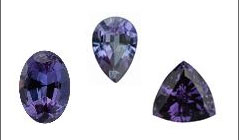 Alexandrite
Alexandrite
A relatively modern gem, alexandrite, like the pearl, is the birthstone for June. It is peculiar in that it changes colour depending on the lighting. When seen in daylight or fluorescent lighting, its colour is in the green range. This may be green with a hint of blue, yellow, brown or even grey. Under incandescent light (halogen lighting or a light bulb), it turns a soft shade of red with a hint of purple, orange or brown. This unique optical property makes it one of the most valuable gemstones of all, especially in fine qualities.
The origin of the word alexandrite comes from the fact that the gem was discovered in 1834, exactly on the 16th birthday of Tsar Alexander II of Russia, which was considered coming of age at the time. Interesting coincidence: the colours of the stone—green and red—were the same as the colours of the Russian imperial guard.Alexandrite is very rare and among the most expensive gemstones. The determining factor in the quality of alexandrite is the degree of colour change. It should be very noticeable and show clear, distinct colours. The quality of the cut of the stone is also a factor. Large alexandrites (more than two carats) are very rare.Brazil is currently the largest producer of alexandrites.

Amethyst
The gem is the most precious member of the quartz family and has long been treasured by kings, queens and religious figures because of its rich royal colour. Indeed, this beautiful purple gem can be traced back to the Minoan period in Greece, twenty-five hundred years before Christ.
It is from the Greek civilization that we find one of the most interesting pieces of lore about amethyst. They believe that wearing the gem, or drinking from goblets cut from the gem would minimize the effects of intoxication! In fact, the word “Amethyst” is from the Greek word meaning literally “not to intoxicate”.
Throughout history, the amethyst has been fashioned into faceted gems, polished into domed shaped “cabochons”, rounded into beads or left in its beautiful rough crystal form. It holds special significance for those born in the month of February
Beautifully intense purple stones are available from such sources as Brazil, where they are expertly irradiated and/or heat-treated to bring out this very desirable colour. This enhancement is permanent so no special care or cleaning technique is required. However, particularly rough wear and tear can erode an amethyst’s polish over a period of time.
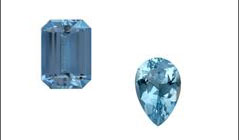 Aquamarine
Aquamarine
This very slightly greenish-blue gemstone is a close relative of the emerald, for they are both members of the beryl family of gems. Its colour, however, is quite unique and can range from nearly colourless with just a hint of blue to an intense, deep blue.
It is not surprising then, that this birthstone for March derives its name from the Latin meaning “sea water”. The azure waters of the Caribbean are a fine comparison for the colour of this gemstone.
The truly intense blue aquamarines of the past are now very scarce and the price for such stones has escalated considerably. Most gems mined today are noticeably paler in hue and this has lead researchers to intensify the colour in modern stones. Careful heating results in the lessening of green hues making enhancement permanent.
The legends connected with aquamarine include the idea that it brings courage to those who wear it and helps to establish happy marriages.
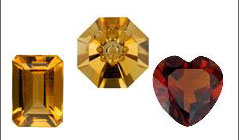
Citrine
The warm hues of a fine citrine are often compared with topaz, and it is no wonder that the two stones are often mistaken for one another. To add to the confusion, both gems are found principally in Brazil, and both are recognized as birthstones for November.
Citrine, however, is a totally distinct gemstone, and is far less costly than the gem it is often mistaken for, topaz. Its name is derived from “citrus”, and this hints of its often yellow hue. Occasionally, citrine possesses a very warm and intense orange colour, and in these instances, it is especially treasured and referred to as “Madeira Citrine”. Such stones are truly an attractive sherry hue.
Citrine is another member of the quartz family of gemstones, and it is interesting to note that some orange and yellow hues are closely achieved by heat-treating the less attractive colours.
This gemstone will hold up well under normal daily wear, but rough treatment will diminish its luster.
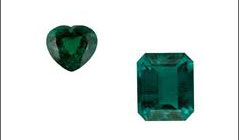
Emerald
It is a magnificent green gemstone, the birthstone for May. Considered among the most rare of gems for centuries, emerald is said to help foretell the future and strengthen one’s memory. Its colour is considered the most soothing and restful to the eye.
The interior of Colombia has always been the most important source of this precious gem. However, in recent years many new sources have emerged including Zambia and Brazil.
Long ago, it was discovered that soaking a rough emerald in colourless oil subdues the natural flaws or “inclusions” found in most stones, and actually improves their transparency. To date, most emeralds are treated in this manner, right at the source. For this reason, ultrasonic cleaners should never be used in cleaning emeralds. The oil may be forced out, thus emphasizing these inclusions. We recommend gentle cleaning with mild soapy water as the correct way to keep emeralds looking their best.
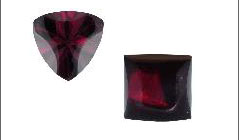
Garnet
The underrated birthstone for January actually occurs in many colours other than the familiar brownish-red. In fact, garnet is available in every colour except blue and offers an excellent variety of choice and price range. It is one of the gems that until now has not needed enhancement to improve its already beautiful colours.
The beautiful and vibrant rhodolite garnet from sources such as Sri Lanka is a violet-red. The rare Tsavorite garnet from Tsavo National Park in Tanzania is an intense green. The bright gold or burnished yellow/brown of the Hessonite garnet can be found right here in Canada. It is consequently quite possible to find the beautiful red colour of a ruby, or even green hue of an emerald, all in a lovely garnet.
Garnet was once believed to give its wearer guidance in the night, allowing one to see where others could not. In one era, weapons were actually carved from the gem with the belief that it would draw blood more effectively. Throughout history, however, garnet has been known as the gem of faith, constancy and truth. This gem is remarkably durable, does not require any special care in wear and cleaning and makes an excellent gemstone for men’s jewellery.
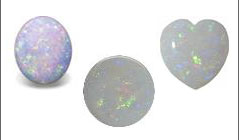
Opal
A gemstone from Australia, it is an exceptional one. The beauty of the opal is derived from flashes and patterns of different colours against a white or grayish background, a phenomenon called “play of colour” by gemmologists. It is the intensity and variety of these different colours that make opals more desirable, valuable and unique, as opals possess their lovely colour combination from nature without enhancement.
Opals contain approximately 10% water in their molecular structure, which plays a part in their magnificent display of colours. Unfortunately, it also affects their durability and contributes to their brittleness. Opals need not be stored in water or oil as commonly believed. However, some care should be taken when wearing opals to avoid sharp blows that could break them. Similarly, consumers should look for protective settings for their gems.
Opals may be kept in your jewellery box along with your other jewellery, provided you cushion them somewhat from being knocked or scratched.
This birthstone for October was falsely portrayed in an 18th century novel as bringing its wearer bad luck. Curiously, this foolish superstition has continued to the present day, although it has been a treasured gem since early Roman times, and was a favourite of Queen Victoria in the 19th century.
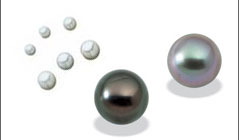
Pearl
This precious gemstone is the birthstone for June. The origin of the word pearl is complex; it was originally called moravid in Persian and markarit in Armenian, which led to its Greek name margaritês or margaron, then its Latin name margarita which means “daughter of the sea.” This last name was chosen by biologists to classify a variety of pearl oysters—Pinctada margaritifera. It is also the likely origin of Margaret as a girl’s name. The Romans, alluding to the elongated shape of pearls worn in pendant earrings, used the word pirla, a slang word for pira, which means pear. Eventually, this was the term adopted by all the modern Latin languages that developed out of the legions’ slang.
It was said that pearls were the solidified tears of Venus and that they consequently preserved young brides from tears. Some claim that pearls make a young woman pure, and that they are a symbol of faith, purity and religious fervour. This is probably why they are so often given to girls at their first communions.
For the Ancients, pearls symbolized purity and innocence. They were dedicated to the moon and to Diana, the goddess of the moon. Young virgins accordingly wore them as a symbol of purity and chastity, and to call on the protection of chaste Diana.
The different colours of pearls had different meanings. Golden pearls symbolized riches; white ones, idealism; black ones, philosophy; pink, beauty; red, health and energy; and grey, thought. Dull pearls brought bad luck.
The pearl was the queen of gems until the beginning of the 20th century. Between 1890 and 1920, they reached prices never matched. People were crazy about pearls, and it was then that the fishing grounds of the Persian Gulf reached the height of their fame.The introduction of cultured pearls on the market around 1920 caused a collapse of the natural pearl market. Today, the natural pearl market is mainly a resale market, as very few are harvested anymore, even though they sometimes command huge prices.
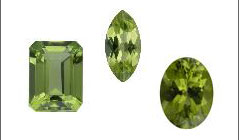
Peridot
The birthstone of August has a delicate springtime-green colour that is unique in the gem world, and its chemistry ensures that this gemstone only occurs in this particular hue, without the current enhancement techniques used by man to beautify gemstones.
Originally mined only on an obscure island off the coast of Egypt, peridot can also be found in Arizona, on a small Indian reservation. This is most fortunate because in early days, the mining was extremely dangerous as the island was snake infested. To make matters worse, peridot was generally unearthed at night only when its colour made it easily seen against the surrounding rock material. Undoubtedly, this contributed to its rarity and corresponding expense!
Considered a powerful amulet against evil, the gem itself is vulnerable to hard blows and excessive scratching. Peridot should be given a little extra care although it can be worn every day.
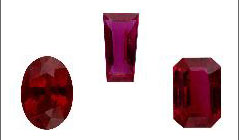
Ruby
It has been known for centuries as the “King of Gems”. This precious gemstone is the birthstone for July, and has always been one of the most sought after gems. Legend has it that a ruby has the power to end a lover’s dispute and rekindle desire. Ancient medics associated its red colour with blood and relied heavily on its mystical healing properties.
We know that the ruby is the most rare of the Corundum family of gemstones, of which sapphire is also a member. Its intense red hue is totally unique in the gem world, and the rubies of Burma have long been considered among the finest available. Rubies from other sources, such as Thailand and East Africa, usually contain iron which gives a purplish tone, and is less appealing than the pure “pigeon blood” red of Burmese stones.
Owing to the limited availability of the finest stones, most rubies are put through a complex heating process to enhance their colour.
These heating techniques are closely guarded family secrets and can result in more desirable red hues, although only a small percentage of stones are successfully enhanced. Nevertheless, the improved colour of these rubies is quite permanent, and no special care is required to maintain their brilliance.
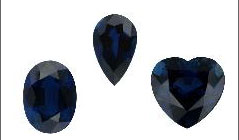
Sapphire
Few people realize that this gemstone, the birthstone for those born in September, is available in every colour imaginable, except red. Although the intense velvety blue hue of Sri Lanka and Kashmir sapphires have been the most sought after through the ages, beautiful yellows, pinks, purples and others are also available today. These “fancy” colours are at present found in sources such as Australia and especially East Africa.
The legends associated with the sapphire are numerous. The ancient Persians, for example, believed that the earth rested on a giant sapphire. Other early cultures wore the stone as protection against poisoning. All through the ages, the sapphire has symbolized truth, sincerity and constancy.
Many of these people actually reburied stones of poorer colour, believing that being “unripe”, they would improve with time back in the ground. As time went on, more scientific minds discovered that when paler tones and stones of less attractive hue were “baked” or heated, colour could be improved. As with rubies, this practise has continued right up to the present in many countries where sapphires are mined. Those involved in the treatment, consider the complex process to be simply the completion of what Mother Nature started.
No special care is required to maintain the beauty of sapphires. Indeed, the durability of the gem, even those heat-treated, is excellent. Regular jewellery cleaning methods are quite suitable.
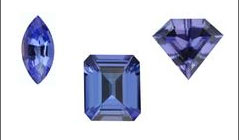
Tanzanite
This gemstone is one of three representing December. It is the most precious variety of the mineral zoisite. Before its discovery in 1967, the only varieties of zoisite that had any pretensions as gem material were the pink ornamental mineral known as thulite, and the green chrome-rich material that acts as the matrix for the large hexagonal crystals of ruby found in Tanzania, which is called “ruby in zoisite”. The name zoisite comes from the name of its discoverer, the Austrian Baron Von Zoïs, who discovered it in 1967 in Tanzania, hence the name tanzanite.
Tanzanite is a transparent gemstone; its colour varies from blue to violet to bluish purple. These shades of blue take on a more purple tinge when viewed under incandescent light. The blue colour of tanzanite is rarely natural—it is generally a result of heat treatment.The transparent crystals of zoisite are found in various colours: blue, green, yellow, pink, brown and khaki. These shades of colour turn to the favoured blue on careful heat treatment, and this is usually carried out. Thulite is translucent to opaque pink, often mottled or streaked with grey or white. Ruby in zoisite is translucent to opaque rock-like ornamental material with ruby crystals in green zoisite.
Tanzanite is not a tough gem; it is rather fragile. Its impact resistance is rated as medium to low. It discolours and melts under the heat of a jeweller’s blowtorch. What’s more, it fractures easily at high temperatures or when subjected to a sudden change in temperature.
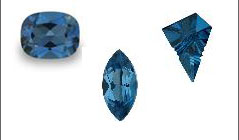
Topaz
The warm hues of a fine topaz are what most people picture when they think of the precious birthstone for November.
Topaz comes in other colours, the most notable being icy blue.
Brazil is a source for most topaz, including the beautiful “imperial” topaz, which is a slightly pinkish orange colour, reminiscent of a lotus blossom, or sherry.
Blue topaz has become increasingly popular in recent years, as a wonderful alternative to aquamarine. This icy blue coloured topaz is a much more brilliant stone, and because it is more prevalent in nature, it is far more affordable than aquamarine. This intense blue gem is enhanced at the source, with a process that is completely harmless, and it creates a beautiful hue which is permanent under normal wear and tear.
Conventional jewellery cleaners are safe to use on all colours of topaz, so it’s quite convenient to keep your topaz jewellery looking its best. As with all jewellery, it is best to let your professional jeweller clean and check your pieces on a regular basis.
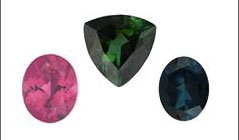
Tourmaline
October is also the month of tourmaline. Its name is derived from the Singhalese word “tura mali” meaning “stone with mixed colours”. Tourmaline is best known for displaying several colours in the same gemstone, from red to green and from blue to yellow. The reason, according to an old Egyptian legend, is that the tourmaline, on its journey up from the Earth’s centre, passed through a rainbow. In doing so, it assumed all the colours of the rainbow. Today, it is still referred to as the “gemstone of the rainbow”. One multi-colour variety is known as watermelon tourmaline, and features green, pink, and white colour bands. To resemble its namesake, the gemstone is cut into thin slices having a pink centre, white ring, and green edge.
Tourmaline has become a favourite among jewellery designers and gem collectors throughout the world. Since it is available in a wide variety of colours, it is ideally suited to almost anyone’s taste.
Tourmaline is found in many localities including Brazil, Afghanistan, East Africa, and the USA.
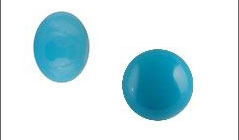
Turquoise
The name turquoise, from the French expression Pierre tourques or Turkish stone, originated in the thirteenth century and describes one of the oldest known gemstones. Turquoise varies in colour from greenish blue, through robin’s egg-blue, to sky blue shades and its transparency ranges from translucent to opaque. Its shining sky blue is one of the most popular trend colours in the world of jewellery and fashion.Throughout the world turquoise has been worn as natural protection against the powers of darkness. In earlier times this gemstone was used to protect horse and rider from unexpected falls. It is still considered a symbol of protection particularly for pilots, aircrews and other high-risk professions.
In modern gemstone therapy, those suffering from depression are recommended to wear a turquoise or a chain with turquoise beads. The cheerful colour of the turquoise is said to provide confidence to quiet and reserved individuals. It is also a stone of friendship, symbolizing faithfulness and constancy in relationships.Turquoise is plentiful and available in a wide range of sizes. This gemstone is also allocated to December.
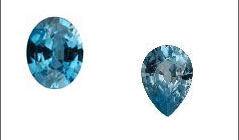
Zircon
December is also the month of zircon. Zircons are transparent, but can be colourless, blue, yellow, green, brown, orange, red, and occasionally purple. Because of its vast range of colours, zircons may be confused with many gems, including diamond, topaz, aquamarine, demantoid and spessartine garnets, heliodor, green beryl and chrysoberyl.
Zircons are very resistant to acids and other chemicals. However, the colour heat- treated stones may revert to their original colour in daylight. Steamer and ultrasonic cleaners are not recommended for cleaning jewellery set with a zircon.
The most popular colour is a pastel blue, but some exceptional gems have a bright blue colour. Most zircons are heat treated to improve their colour particularly blue and golden. Blue zircons were widely used until the middle of the 20th century. Generally speaking, zircons are a vivid and attractive colour and are readily available and affordable. Zircon jewellery should be stored carefully because although zircon is relatively hard, it can abrade and facets can chip. Dealers often wrap zircons individually so that they will not knock against each other in a parcel.
The main deposits are in Cambodia, Sri Lanka, Thailand, Myanmar and Australia.
